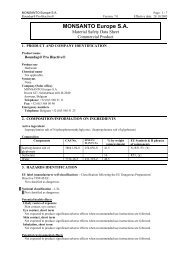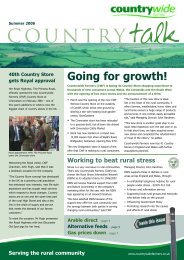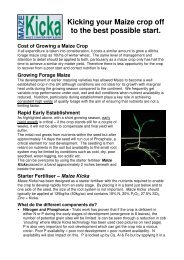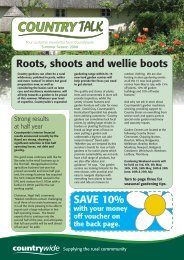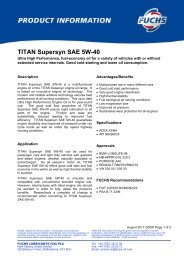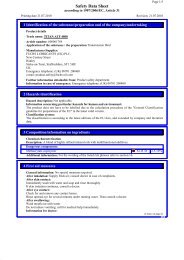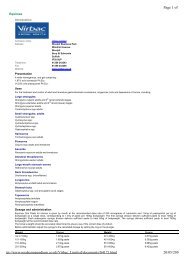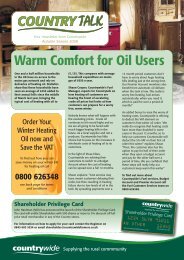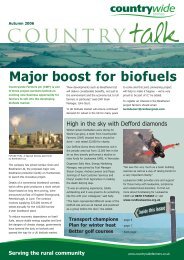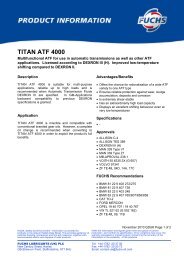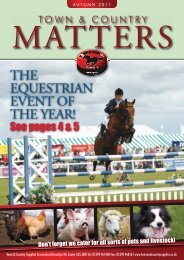How to choose horse bedding - Countrywide Farmers
How to choose horse bedding - Countrywide Farmers
How to choose horse bedding - Countrywide Farmers
Create successful ePaper yourself
Turn your PDF publications into a flip-book with our unique Google optimized e-Paper software.
Horse <strong>bedding</strong> is not a straightforward choice. It can depend on a number of fac<strong>to</strong>rs includingcost, transport, s<strong>to</strong>rage, disposal and the individual. In general, the most common types of<strong>bedding</strong> used are straw and shavings. There are also several other options available at<strong>Countrywide</strong>:Wheat StrawWhen baled, it is often heavily compacted and brittle, affecting its durability and reducing itsvalue as <strong>bedding</strong>. Good wheat straw makes excellent <strong>bedding</strong>. It is still the most popular<strong>bedding</strong>. It can be used for a deep litter, and it will take you four <strong>to</strong> six bales <strong>to</strong> start a bed. Youwill need around five bales a week for a <strong>horse</strong> that is stabled at night.AdvantagesWheat Straw is cheap, easily available, absorbent, warm and easy <strong>to</strong> muck out. It rots downwell, and is easy <strong>to</strong> dispose of in a muck heap or can be sold or given away as it makes a goodgarden fertiliser.DisadvantagesWheat Straw is not suitable for <strong>horse</strong>s with dust allergies or respira<strong>to</strong>ry problems. It can bevery dusty and poorer quality straw can be mouldy <strong>to</strong>o. S<strong>to</strong>rage can be a problem - bales needa lot of space in a dry area.Oat StrawOat straw is palatable and more expensive. It quickly becomes saturated, which makes it theleast suitable straw for <strong>bedding</strong>.AdvantagesFirstly it gives a clean and bright appearance. Straw manure can be disposed of more easilythan other types of materials. In a good harvest year it can be cheap.DisadvantagesSome <strong>horse</strong>s will eat the straw and it can cause several problems such as allergic coughing <strong>to</strong>the dust. In a bad harvest it can be quite expensive.Wood ShavingsWood Shavings are a popular form of <strong>bedding</strong> as they are very absorbent and easy <strong>to</strong> muckout. It is important <strong>to</strong> buy wood shavings that have been specially produced for use as animal<strong>bedding</strong>. If you use alternative wood shavings, such as waste from a saw mill, you may find theshavings are sharp and contain rubbish. Wood shavings can be used for a deep litter and willtake four <strong>to</strong> five bales <strong>to</strong> start a bed. You will need one or two bales a week for a <strong>horse</strong> that isstabled at night. They can be expensive.AdvantagesWood Shavings are easy <strong>to</strong> muck out, easily s<strong>to</strong>red and easily disposed of (they will burn). Theyare absorbent and for allergic <strong>horse</strong>s, dust-free (or dust-extracted) shavings are available.DisadvantagesIf you are unable or concerned about burning the shavings <strong>to</strong> dispose of the waste, woodshavings can be hard <strong>to</strong> get rid of. They take a long time <strong>to</strong> rot down and are generallyunwelcome on muck heaps.
Wood FibreWhite wood fibre products have recently introduced <strong>to</strong> this expanding market, manufacturedfrom carefully selected recycled whitewood fibre.AdvantagesEnvironmentally friendly product. Fairly dust free <strong>bedding</strong> that is warm, comfortable andsupportive. Free-draining bed that stays dry on <strong>to</strong>p. Horses also stay cleaner as it doesn’t cling<strong>to</strong> manes, tails or rugs.DisadvantagesBales are often small due <strong>to</strong> heavier weight of product and can become heavy when muckingout, due <strong>to</strong> high absorbency.Shredded PaperShredded Paper is becoming more popular as a choice of <strong>bedding</strong> as it is one of the cheapes<strong>to</strong>ptions and has many advantages. It is not suitable for a deep litter bed. It will take five bales<strong>to</strong> start a bed and one or two bales a week for a <strong>horse</strong> that is stabled at night. Newsprint hasthe same insulation qualities and s<strong>to</strong>rage qualities of straw or wood shavings, but requires morecleaning and maintenance. For grooming qualities, shredded paper is excellent because it keeps<strong>horse</strong>s cleaner than other <strong>bedding</strong> products.AdvantagesShredded Paper is completely dust free and is an excellent choice for allergy-suffering <strong>horse</strong>s.It's easy <strong>to</strong> s<strong>to</strong>re, light <strong>to</strong> work with, quite absorbent, very warm in the Winter and can becheap.DisadvantagesThe most effective method of disposal would be <strong>to</strong> burn it. It can be difficult <strong>to</strong> keep a tidymuck heap as shredded paper tends <strong>to</strong> blow around in the wind. The dye from the paper cansometimes mark a <strong>horse</strong>'s coat and it can ball up leaving a bare floor for the <strong>horse</strong> <strong>to</strong> lie on.Wood PelletsWhite wood fibre products that have been heat treated and compressed. When water is added<strong>to</strong> the pellets they expand in size and can absorb nine times more liquid than regular shavings.AdvantagesEnvironmentally friendly product. Dust free <strong>bedding</strong> that is highly absorbent. In addition, woodpellet <strong>bedding</strong> composts much quicker than shavings or straw which often do not fully compos<strong>to</strong>r take a long time <strong>to</strong> decompose.DisadvantagesCan be slippery whilst still in pellet form. Need <strong>to</strong> add water <strong>to</strong> <strong>bedding</strong> when initially put down<strong>to</strong> make if fluff up.HempHemp is a relatively new type of <strong>bedding</strong>. It is a natural fibre derived from the hemp plant. Itcan be used in a deep litter bed, and can be shown <strong>to</strong> be economical in the long run.AdvantagesHemp has good absorbency qualities and makes a very soft bed. It is dust free and breaksdown very quickly. It is ideal for a deep litter bed.DisadvantagesHemp is initially expensive, it is not edible and may cause swelling <strong>to</strong> a <strong>horse</strong>'s s<strong>to</strong>mach ifingested.Rubber Matting
Rubber matting has many advantages and while initial costs can be high, running costs can bepractically non-existent. Once fitted, running costs can be very low.AdvantagesCompletely dust free and can be used with a <strong>bedding</strong> of your choice. Drains well and is warm.Very safe for your <strong>horse</strong> - soft rubber reduces risk of injury. Easy <strong>to</strong> muck out.DisadvantagesIf your <strong>horse</strong> is messy, then the no <strong>bedding</strong> option may make the <strong>horse</strong>/rugs dirty. Some extra<strong>bedding</strong> may also be required <strong>to</strong> s<strong>to</strong>p draughts. Initial cost is high. The stables need <strong>to</strong> havegood drainage if no <strong>bedding</strong> is used <strong>to</strong> absorb the urine.The Importance of Good Stable MaintenanceMaintenance of stables and a good mucking out routine is paramount <strong>to</strong> ensure your <strong>horse</strong> hasa healthy environment <strong>to</strong> live in. Follow these ten tips <strong>to</strong> ensure your <strong>horse</strong> has a clean andhealthy stable environment.1. Clear the area. Take your <strong>horse</strong> out of the stall and removes any objects such as feed andwater buckets.2. Keep a cleaning kit <strong>to</strong> hand include a wheelbarrow, shavings or manure fork and a yardbroom.3. Clear all the soiled <strong>bedding</strong>. Remove manure and wet <strong>bedding</strong> thoroughly.4. Dump the waste product in the assigned area, ensuring it is well away from the stable. Muckheaps can attract flies and other parasites which can provide a nuisance fac<strong>to</strong>r as well asspreading disease among <strong>horse</strong>s.5. Once all waste has been removed spread the lef<strong>to</strong>ver <strong>bedding</strong> in the stable.6. Add fresh <strong>bedding</strong> <strong>to</strong> replace the amount removed. Buff the <strong>bedding</strong> up with a fork <strong>to</strong>maximise comfort and warmth.7. Have a routine complete clean out when once a week or a fortnight, where the stable iscompletely stripped out. Use a disinfectant such as Virkon <strong>to</strong> prevent the spread of disease. Letthe stable dry out completely before re-<strong>bedding</strong>.8. Clean up outside the stable. Any residue dirty <strong>bedding</strong> will carry disease so make sure allwaste is tidied away and dumped on the manure heap.9. Replace the feeding equipment and <strong>to</strong>ys that were removed <strong>to</strong> enable an effective clean.10. Return the <strong>horse</strong> in<strong>to</strong> a better, healthier and cleaner living environment.DisclaimerThe information in this publication is meant as a brief and general guide only and is not intended <strong>to</strong> bespecific advice, or an exhaustive treatment of the subject. <strong>Countrywide</strong> <strong>Farmers</strong> plc advises that youshould always consult a professional, as it is possible that the information in this guide may not relate <strong>to</strong>your particular situation. Whilst <strong>Countrywide</strong> <strong>Farmers</strong> plc endeavours <strong>to</strong> keep this publication up <strong>to</strong> dateand correct we make no representations or warranties of any kind, express or implied, about thecompleteness, accuracy, reliability or suitability of the guide. Any decisions based on information containedin the guide are the reader’s sole responsibility. To the fullest extent permitted by applicable law<strong>Countrywide</strong> <strong>Farmers</strong> plc accepts no responsibility for any loss or damage as a result of any reliance placedupon information given in this guide by the reader or anyone <strong>to</strong> who such information is communicated.




